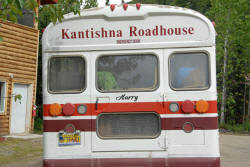
"Harry," our bus for 13 hour tour in Denali Park. The whole park is
6 million acres - larger than Massachusetts!! |
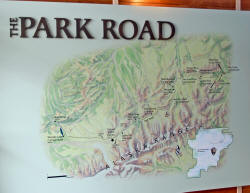
Destination: Kantishna Roadhouse, 95 miles into the park |
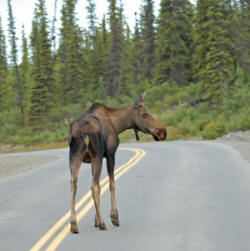
We had just begun the road trip, when we were stopped by this poor
moose. She was limping, one of her legs or feet injured. |
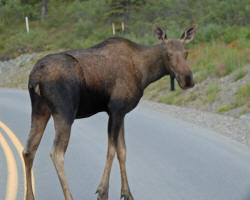
So sad to see - she was very thin and will probably not live through
the coming winter. The Park has a "hands off" policy; i.e., let
nature take its own course. |
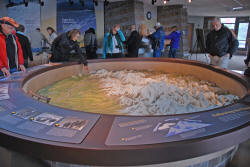
A display of part of the 600-mile-long Alaska Range at Eielson
Visitor Center (mile 66 of trip). This display had lighted paths
that mountain climbers use. |
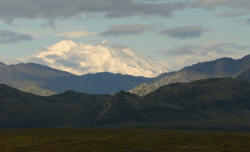
Only about 30% of visitors get to see any part of Mt. McKinley due
to the mostly cloudy weather at those heights. We were of the lucky
5% that not only got to view the mountain, but got to see both
peaks!! |

South Peak: 20,320 feet high
North Peak: 19,470 feet |
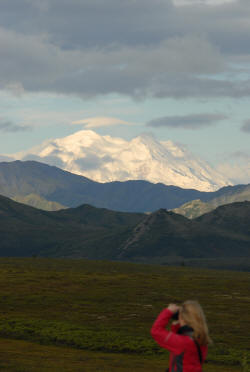 |
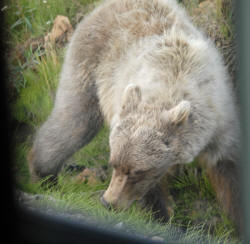
This young bear walked right in front of the bus and began muching
along side. |
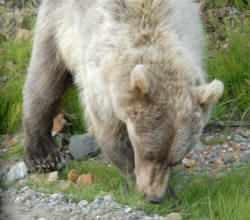
Look at them thar' claws!! I guess it is a good thing we were not
allowed to get off the bus. |
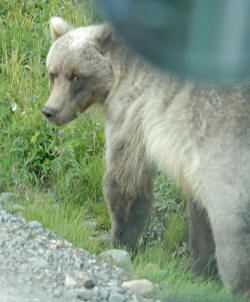
"nah, nah, nah . . . you can't come out here!" |
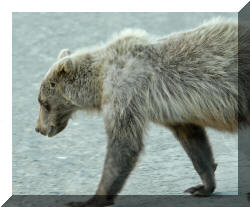
"Well, I'll mosey along now . . . go look for mama" |
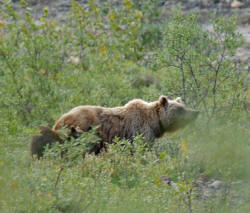
Another mama grisly with baby near her backside |
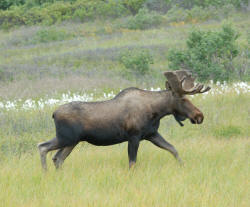
Bull Moose |
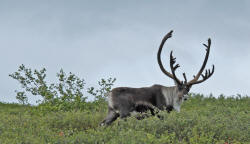
Caribou, aka Reindeer- both males
and females grow antlers, and a new set each year!
Caribou
antlers is the fastest growing tissue in the animal world.
|
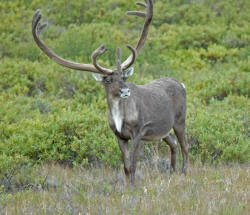
Antler
development is 3-6 months out of phase between the sexes. For
example, the male's antlers begin developing in March, grow rapidly
from May to July, and are completely hardend and out of velvet by
mid-September. Following the rut, antlers are shed in early November
by older males, but may be kept until April by some of the younger
ones. Female antlers develop from June to September and are out of
velvet by late September. The females' antlers are retained
throughout the winter. Pregnant females drop their antlers within
days of calving. Barren cows shed their antlers before the spring."
(Info from the Government of the Northwest Territories, Division of
Natural Resources.) |
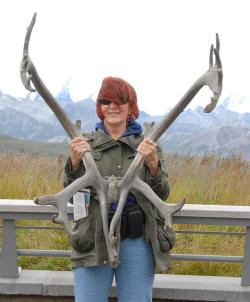
These real caribou antlers are HEAVY! Caribou must have very strong
necks and shoulders!! |

Mel, posing as caribou |
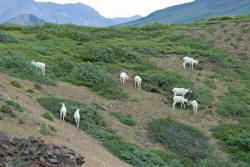
These are known as "Dall Dots" which means Dall Sheep too far away
to photograph in detail. Dall sheep, named for American Naturalist
William Dall, tend to be found on steep slopes with extremely rugged
ground in the immediate vicinity, to allow escape from predators
that cannot travel quickly through such terrain |

This is what a Dall sheep looks like: display at
Denali Visitor Center |
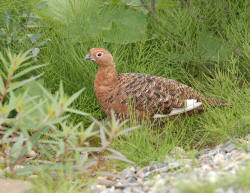
The Willow Ptarmigan is the Alaska State Bird.
In winter months the willow ptarmigan eats mosses and lichens,
willow buds and twigs, a little birch; seeds and berries when
available (internet source) |
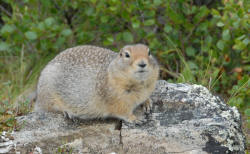
Arctic Ground Squirrel . . . sooo cute!
Too bad, it is prey to the Arctic Fox, wolverine, lynx, Grisly Bear,
and eagles - run, squirrel, run!!
Let's see if I have this correct - these squirrels are non-arboreal,
i.e., they don't climb trees like other squirrels; they forage for
food in the tundra. This one is definitely fattening up for
hibernation!!
Interesting trivia from wikipedia:
During hibernation (early September to late April), its brain and
core temperature can drop to just above freezing and its heartbeat
drops. Peripheral, colonic, and blood temperatures become subzero by
means of supercooling. Body temperatures drop as low as
−2.9 °C
(26.8 °F) (average
−3 °C
(27 °F)), the lowest known
naturally occurring core body temperature in mammals |